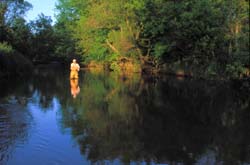 |
|
-June 2006- |
|
Falling Down the Rabbit Hole
NPDES Permit Program The purpose of the 1972 Clean Water Act (CWA) was to restore and maintain the physical, chemical and biological integrity of our nations' waterways (also referred to as achieving "zero discharge"). A core component of the CWA, the National Pollutant Discharge Elimination System, or NPDES, requires all "point source" and some "nonpoint source" pollutant dischargers to get a permit from the Illinois Environmental Protection Agency (IEPA).
Many people think that the term "point source" refers only to contaminants discharged from a pipe. In fact, the CWA broadly defines "point source;" it includes discharges that are contained and readily discernable. Under this definition, point source discharges can originate from a variety of conveyance points, including ditches, wells, conduits and any floating watercraft that may discharge contaminants.
In 1987, CWA amendments recognized the growing scientific evidence that "nonpoint source" pollution contributes more than half of the pollutants entering our waterways. These amendments added regulations requiring NPDES permits for some nonpoint (or "stormwater") discharges. Unlike point source pollution, nonpoint sources are not discharged from a specific outlet. Examples of nonpoint sources include effluents from timber, textile and food processing, concentrated animal feedlot operations (CAFO), wastewater from mining activities, and contaminants leaching from landfills.
 NPDES permits are issued for five years. Before IEPA approves any new permit, permit renewal, or modification of a permit, NPDES regulations require the agency to give notice of the permit application and to provide a 30-day period for public comment. The public comment period is the time for citizens to take action, but presenting meaningful information to the IEPA requires homework. If you do not have good information on the water conditions in your area, go to
NPDES permits are issued for five years. Before IEPA approves any new permit, permit renewal, or modification of a permit, NPDES regulations require the agency to give notice of the permit application and to provide a 30-day period for public comment. The public comment period is the time for citizens to take action, but presenting meaningful information to the IEPA requires homework. If you do not have good information on the water conditions in your area, go to
http://www.epa.state.il.us/water/water-quality/index.html
For detailed information on the Clean Water Act, the NPDES permit process, and citizens rights under the CWA, check the Federal and Illinois EPA websites:
http://www.epa.state.il.us/water/permits/waste-water/contacts.html
TMDL Watershed Restoration Plan Another important component of the CWA is the TMDL program. Section 303(d) of the Act requires states to measure the levels of particular pollutants (such as mercury or nitrogen) in their waterways. Waterways which exceed the TMDL (total maximum daily loads) are considered "impaired," and must be prioritized and listed in an annual report called the 303(d) List.
Unlike the NPDES program, the focus of a TMDL plan is to take a comprehensive watershed approach towards improving water quality. For rivers and lakes that exceed TMDL requirements, states must develop a plan for reducing the levels of pollutants until the waterway can support "beneficial uses," or "designated uses" (examples of designated uses include drinking water, supporting aquatic life, and water-related recreational activities such as swimming).
In Illinois, developing the 303(d) TDML list requires collecting data on physical, biological, chemical, toxicity levels, and the habitats of rivers and streams, inland lakes, Lake Michigan and groundwater. Because TMDLs are developed using a watershed approach, data collection must also include information about watershed characteristics such as topography, precipitation, geology and land use.
As the IEPA is collecting data on watersheds, citizens need to provide information for them to consider in creating both the draft and final TMDL, although it is best to submit comments as early in the process as possible. You can find a list of current TMDLs and their status at http://www.epa.state.il.us/water/tmdl/report-status.html.
As with the NPDES program, commenting on a TMDL requires research and preparation. The federal EPA has a website dedicated to specific watershed information and links to other resources at http://www.epa.gov/surf
Contact Prairie Rivers Network (217)344-2371 if you have questions about TMDLs.. More TMDL specifics can also be found on these Federal and Illinois EPA websites:
http://www.epa.state.il.us/water/tmdl/index.html